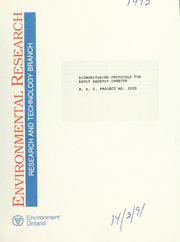
Biomonitoring Protocols for Adults Aquatic Insects PDF
Preview Biomonitoring Protocols for Adults Aquatic Insects
no BIOMONITORING PROTOCOLS FOR ADULT AQUATIC INSECTS R. A. C. PROJECT NO. 322G Environment Ontario ISBN 0-7729-7527-2 BIOMONITORING PROTOCOLS FOR ADULT AQUATIC INSECTS R. A. C. PROJECT NO. 322G Prepared for Environment Ontario by: Z.E. lîovats, J.H. Ciborowski and L.D. Corkum MARCH 1991 o Ksrrcuiii Cette publication technique n'est disponible qu'en anglais. log 90-9300-322G PIES 1493 ACKKOWLEDGEMENT AND DISCLAIMER This report was prepared for the Ontario Ministry of the Environment as part of a Ministry funded project. The views and ideas expressed in this report are those of the author and do not necessarily reflect the views and policies of the Ministry of the Environment, nor does mention of trade names or commercial products constitute endorsement or recommendation for use. The Ministry, however, encourages the distribution of information and strongly supports technology transfer and diffusion. Any person who wishes to republish part or all of this report should apply for permission to do so to the Research and Technology Branch, Ontario Ministry of the Environment, 135 St. Clair Avenue West, Toronto, Ontario, M4V 1P5, Canada. Copyright: Queen's Printer for Ontario. This publication may be reproduced for non-commercial purposes with appropriate attribution. ACKNOWLEDGEMENTS We wish to thank S. Pernal and R. Thibert for assistance with all aspects of field collection and sample processing during 1987 and 1988. We are indebted to B.S. Muncaster for piloting the boat on Lake St. Clair and for helping with dispersal studies. S.A. Beckett, M.E. Dunnigan, D. Gagnier, B.C. Uanes, C. Hébert, K. Kocot, P. Marignani, and S.C. Yousuff also assisted with various field studies. Dr. M.Q. Henry (Minnesota Fish & Wildlife Co-op, Uni- versity of Minnesota, Minneapolis) collaborated on a simultaneous collection study conducted on the Canadian and U.S. sides of the Detroit River. Dr. P.L. Hudson (Great Lakes Fisheries Research Laboratory, Ann Arbor) generously provided us with an unpublished species list of Trichoptera of the St. Clair and Detroit rivers. Dr. G.D. Haffner made available laboratory facilities at the Great Lakes Institute, University of Windsor. Dr. R. Lazar, GLI labora- tory, generously gave advice and assistance regarding laboratory processing and analytical procedures. We also thank A. Hayton and W. Scheider (Ontario Ministry of the Environment) for assistance with various aspects of this project. This report was conducted under the auspices of the Research Advisory Committee (R.A.C.) of the Ontario Ministry of the Environment. DISCLAIMER The views and ideas expressed herein are those of the authors and do not necessarily reflect the views and policies of Environment Ontario, nor does mention of trade names or commercial products constitute endorsement or recommendation for use. TABLE OF CONTENTS List of Figures iv List of Tables vi Executive Summary vll 1. INTRODUCTION 1 1.1. Objectives 3 2. MATERIALS AND METHODS 4 2>1. Life cycles of aquatic insects 4 2.2. Sample collection 5 2.2.1* Light trap design and operation 5 2.2.2. Sample processing 8 2.2.3. Collection of emerging adults 9 2.2.3.1. Scoop netting 9 2.2.3.2. Submersed traps for larvae 10 2.2.3.3. Boat-mounted light traps 10 2*2.4. Collection of bottom-dwelling larvae 11 2.3. Contaminant analyses 11 2.3.1. Laboratory procedures 11 2«3.2. Data analyses 13 2.4. Specific studies 15 2.4.1. Detection limits in uncontamlnated samples 13 2.4.2. Minimum sample size 15 2.4.3. Storage time and temperature 17 2.4.4. Dispersal distance studies 17 2.4.4.1. Sample collection 17 2.4.4.2. Sample sorting 18 2.4.4.3. Data analysis 21 2.4.5. Seasonal variation 24 2.4.6. Passive light trapping 24 2.4.7. Interfamilial comparisons 26 2.4.8" Comparison of contaminant burdens of animals differing in lipid content 27 2.4.9. Validation 29 2.4.9.1. Sample collection 29 2.4.9.2. Data analyses. 29 3. RESULTS 33 3.1. Sample collection 33 3.1.1. Trap operation and efficiency 33 3.1.2. Taxonomic composition of samples 34 3.1.3. Collection of emerging adults 35 3.1.3.1. Scoop netting 35 3.1.3.2. Submersed traps for larvae 35 3.1.3.3. Boat-mounted traps 35 3.1.4. Collection of bottom-dwelling larvae 36 3.2. Contaminant analyses 36 3>3. Specific studies 40 3.3.1. Detection limits in uncontamlnated samples 40 3.3.2. Minimum sample size 40 3.3.3. Storage time and temperature 44 11 3<3>4< Boat-mounted light traps 44 3>3<5« Comparison of conteuninant burdens of adults and larvae 47 3«3>6> Dispersal distance studies 49 3>3>7« Seasonal variation 57 3>3«7<1* Abundance of aquatic insects 57 3.3.7.2. Contaminant concentrations 57 3.3. 8. Passive light trapping 62 3«3« 9« Interfamillal comparisons 62 3«3>10< Comparisons of contaminant burdens of animals differing in lipid content 67 3.3.11. Validation 67 3.3.11.1. Sample collection 67 3.3.11*2. Contaminant concentrations 71 3.3.11.2.1. St. Clair River 71 3.3.11.2.2. Detroit River 72 3.3.11.2.3. Niagara River 72 3.3.11.2.4. St. Marys River 74 3.3.11.2.3. Similarity of contaminant burdens among rivers 76 4. SYNOPSIS AND RECOMMENDATIONS 80 4.1. Sampling procedure 80 4.2. Seasonal variation in abundance and contaminant burden 82 4.3. Choice of taxa 83 4.4. Emerging adults and collection of larval Trlchoptera 84 4.5.Comparison of adult and larval contaminant burdens 86 4.6. Minimum sample size and detection limits 86 4.7. Dispersal studies 89 4.8. Relationship between contaminant burden and lipid content 91 4.9. Validation 93 4.10. Conclusions 93 4.11. Recommendations for future work 94 5. REFERENCES 96 6. APPENDICES 99 6.1. Appendix 1. Protocol summary 100 6.1.1. Light trap construction 100 6.1.2. Required materials 100 6.1.3. Collecting procedure 101 6*1.4. Sample sorting and preparation for GC analysis 102 6.2. Appendix 2* Detailed results of contaminant analyses 103 6.3. Appendix 3. List of publications and presentations 115 6.4. Appendix 4. Taxonomic composition of Trlchoptera collected in 1987 samples: Detroit and St. Clair rivers 117 iii
